Rules
Dealing
Dealings starts to the left of the dealer and continues in a clockwise direction until all cards have been dealt. Each player receives 13 cards.
Bidding
Bidding starts with the player on the left of the dealer for the first round. On subsequent rounds, bidding moves in a clockwise direction. The goal of bidding is to determine the trump suit for that round.
- Players must name a number followed by a suit. For example, "Two Diamonds"
- The next player may pass or may announce a stronger bid. Diamonds is the weakest suit, followed by Hearts, then Clubs, and Spades is the strongest. For example, if the previous bid was "Two Diamonds," the next player may announce "Two Spades" which would be a stronger bid. Higher numbers are automatically stronger bids no matter what suit. For example, "Three Diamonds" is a stronger bid than "Two Spades." Players may not bid a higher number than the number of cards they have in their hand of that suit.
- Any player may pass if they do not wish to bid. If all the players pass, the cards are redealt.
The suit of the bid that wins becomes the trump suit for that round. The winner of the bid must place cards of the trump suit into the "bidding pile" equal to the number of cards he bid. If the winning bid for example was "Three Diamonds" then the winner of the bid must place three diamonds into the pile. Other players place the same number of cards of their choice into the bidding pile. The bidding pile is then shuffled and redealt to the players.
Selection of Target Card
After bidding and redealing of the bidding pile, each player chooses one card from their hand to set aside facedown. This card will become the target card for the player.
Winning of Tricks
The player who won the bid starts the play by playing one card. Players in clockwise fashion then play a card of their choice; they must follow suit, if they can, otherwise they may play any card.
The player who played the highest valued card wins the trick. If one or more trump card was played, the highest value trump card wins the trick; otherwise the highest value card of the leading suit wins the trick. The player who won the trick takes the cards in the trick into his "winnings pile," which will be used later to determine the player's score for that round.
The player who won the trick then plays a card to start the next trick. Play continues for 12-rounds, when the players run out of cards. Players have only twelve cards in their hand, because of the target card selected before play began.
Scoring
The point values of the cards are as follows:
- 2,3,4,5 = -15 points (negative fifteen points)
- 6,7,8,9 = 5 points (five points)
- 10, Jack, Queen, King = 10 points (ten points)
- Ace = 15 points (fifteen points)
After play has ended, players look at the cards in their winnings pile. Players take out any pairs, triples, or four-of-a-kinds they have won for scoring, discard any singles, and include their target card (selected at the beginning of the round). Scoring is done by adding up the point values of the pairs, triples, or four-of-a-kinds cards. Having a pair of one card earns the point value of that card, having a triple earns twice that point value, and having a four-of-a-kind earns four times the point value. For example, if the player has in their winnings pile two 3s, a 4, a 6, two 9s, a 10 (the target card), three Jacks, a Queen, and two Aces the player has a score of 25 (-15 for the 3s, 5 for the 9s, 20 for the triple Jacks, 15 for the Aces, and nothing for the 4, 6, 10, or Queen).
An exception to these rules of scoring involves the Target Card selected before each round. Having a triple of the target card gives the player 40 points regardless of the original point value of the card. Having four of the target card gives the player 80 points regardless of the original point value of the card. If the player only has a pair of the target card, then scoring is done normally for that card. For example, if the player has in their winnings pile three 4s and two 10s, and their target card was a 4, then the player scores 50 points (40 points for the triple 4s and 10 for 10s).
Players may have negative scores.
Winning the Game
Rounds are played until a player reaches a total score of 250 points. For longer games, players may continue until they reach 500 points.

Contract bridge, or simply bridge, is a trick-taking card game using a standard 52-card deck. In its basic format, it is played by four players in two competing partnerships, with partners sitting opposite each other around a table. Millions of people play bridge worldwide in clubs, tournaments, online and with friends at home, making it one of the world's most popular card games, particularly among seniors. The World Bridge Federation (WBF) is the governing body for international competitive bridge, with numerous other bodies governing it at the regional level.

Pinochle, also called pinocle or penuchle, is a trick-taking, Ace-Ten card game typically for two to four players and played with a 48-card deck. It is derived from the card game bezique; players score points by trick-taking and also by forming combinations of cards into melds. It is thus considered part of a "trick-and-meld" category which also includes the game belote. Each hand is played in three phases: bidding, melds, and tricks. The standard game today is called "partnership auction pinochle".

A trick-taking game is a card or tile-based game in which play of a hand centers on a series of finite rounds or units of play, called tricks, which are each evaluated to determine a winner or taker of that trick. The object of such games then may be closely tied to the number of tricks taken, as in plain-trick games such as contract bridge, whist, and spades, or to the value of the cards contained in taken tricks, as in point-trick games such as pinochle, the tarot family, briscola, and most evasion games like hearts. Trick-and-draw games are trick-taking games in which the players can fill up their hands after each trick. In most variants, players are free to play any card into a trick in the first phase of the game, but must follow suit as soon as the stock is depleted. Trick-avoidance games like reversis or polignac are those in which the aim is to avoid taking some or all tricks.
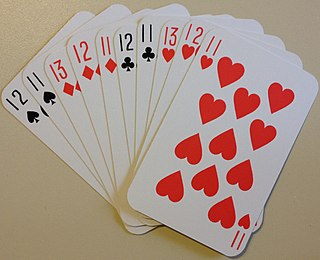
500 or Five Hundred is a trick-taking game developed in the United States from Euchre. Euchre was extended to a 10 card game with bidding and a Misere contract similar to Russian Preference, producing a good cut-throat three player game like Preference and a four player game played in partnerships like Whist which is the most popular modern form, although with special packs it can be played by up to six players. It arose in America before 1900 and was promoted by the US Playing Card Company, who copyrighted and marketed a deck with a set of rules in 1904. The US Playing Card Company released the improved Avondale scoring table to remove bidding irregularities in 1906. 500 is a social card game and was highly popular in the United States until around 1920 when first auction bridge and then contract bridge drove it from favour. It continues to be popular in Ohio and Pennsylvania, where it has been taught through six generations community-wide, and in other countries: Australia, New Zealand, Canada and Shetland. Despite its American origin, 500 is the national card game of Australia.
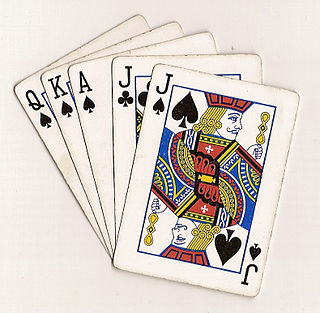
Euchre or eucre is a trick-taking card game commonly played in Australia, Canada, Great Britain, New Zealand and the Midwestern United States. It is played with a deck of 24, 28, or 32 standard playing cards. Normally there are four players, two on each team, although there are variations for two to nine players.

Spades is a trick-taking card game devised in the United States in the 1930s. It can be played as either a partnership or solo/"cutthroat" game. The object is to take the number of tricks that were bid before play of the hand began. Spades is a descendant of the Whist family of card games, which also includes Bridge, Hearts, and Oh Hell. Its major difference as compared to other Whist variants is that, instead of trump being decided by the highest bidder or at random, the Spade suit always trumps, hence the name.
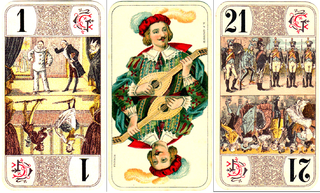
The game of French Tarot is a trick-taking strategy tarot card game played by three to five players using a traditional 78-card tarot deck. The game is the second most popular card game in France and is also played in French-speaking Canada.
Rubber bridge is a form of contract bridge played by two competing pairs using a particular method of scoring. A rubber is completed when one pair becomes first to win two games, each game presenting a score of 100 or more contract points; a new game ensues until one pair has won two games to conclude the rubber. Owing to the availability of various additional bonus and penalty points in the scoring, it is possible, though less common, to win the rubber by amassing more total points despite losing two games out of three. Rubber bridge involves a high degree of skill but there is also a fair amount of luck involved in who gets the best cards. A popular variation of rubber bridge is known as Chicago.
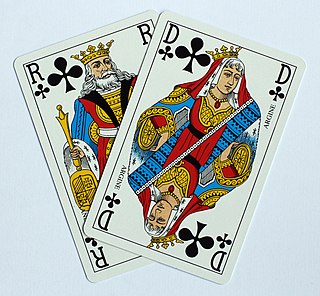
Belote is a 32-card, trick-taking, Ace-Ten game played primarily in France and certain European countries, namely Armenia, Bulgaria, Croatia, Cyprus, Georgia, Greece, Luxembourg, Moldova, North Macedonia, Bosnia and Herzegovina and also in Saudi Arabia. It is one of the most popular card games in those countries, and the national card game of France, both casually and in gambling. It appeared around 1900 in France, and is a close relative of both Klaberjass and Klaverjas. Closely related games are played throughout the world. Definitive rules of the game were first published in French in 1921.
Pedro is an American trick-taking card game of the All Fours family based on Auction Pitch. Its most popular variant is known as Cinch, Double Pedro or High Five which was developed in Denver, Colorado around 1885 and soon regarded as the most important American member of the All Fours family. Although it went out of fashion with the rise of Auction Bridge, it is still widely played on the western coast of the United States and in its southern states, being the dominant game in some locations in Louisiana. Forms of the game have been reported from Nicaragua, the Azores, Niobe NY, Italy and Finland. The game is primarily played by four players in fixed partnerships, but can also be played by 2–6 individual players.

Bid whist is a partnership trick-taking variant of the classic card game whist. As indicated by the name, bid whist adds a bidding element to the game that is not present in classic whist. Bid whist, along with spades, remains popular particularly in U.S. military culture and a tradition in African-American culture.
Pitch is the American version of the English trick-taking game of Blind All Fours which, in turn, is derived from classic All Fours. Historically, Pitch started as "Blind All Fours", a very simple All Fours variant that is still played in England as a pub game. The modern game involving a bidding phase and setting back a party's score if the bid is not reached came up in the middle of the 19th century and is more precisely known as Auction Pitch or Setback.
These terms are used in contract bridge, using duplicate or rubber scoring. Some of them are also used in whist, bid whist, the obsolete game auction bridge, and other trick-taking games. This glossary supplements the Glossary of card game terms.
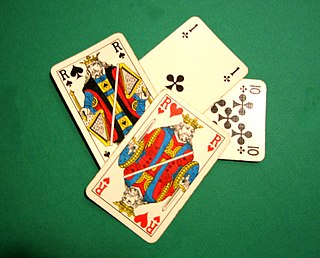
Twenty-eight is an Indian trick-taking card game for four players, in which the Jack and the nine are the highest cards in every suit, followed by ace and ten. It thought to be descended from the game 304, along with similar Indian games known as "29", "40" and "56".
304, pronounced three-nought-four, is a trick-taking card game popular in Sri Lanka, coastal Karnataka, Tamil Nadu and Maharashtra, in the Indian subcontinent. The game is played by two teams of two using a subset of the 52 standard playing cards so that there are 32 cards in play.

The following is a glossary of terms used in card games. Besides the terms listed here, there are thousands of common and uncommon slang terms. Terms in this glossary should not be game-specific, but apply to a wide range of card games. For glossaries that relate primarily to one game or family of similar games, see Game-specific glossaries.
Russian Schnapsen, Thousand Schnapsen, 1000 or Tysiacha is a trick-taking game of the Ace-Ten family for three players, the aim of which is to score over 1000 points to win the game. It is a variant of the popular Austrian game of Schnapsen. Like its parent, Russian Schnapsen features "marriages" which are worth extra points.

Bavarian Tarock or, often, just Tarock, is a card game that was once popular in Bavaria and also played in parts of Austria as well as Berlin. The name is a clue to its origin in the historical German game of [Gross-]Tarock, a game using traditional Tarot cards. At some point in the mid- to late-18th century, attempts were made to emulate Taroc using a standard 36-card German-suited pack, resulting in the formerly popular, south German game of German Tarok. During the last century, the variant played with a pot (Haferl) and often known as Bavarian Tarock or Haferltarock, evolved into "quite a fine game" that, however, has less in common with its Tarock progenitor. German Tarok also generated the very similar game of Tapp, played in Württemberg, and both are related to Bauerntarock, Dobbm and the American games of Frog and Six-Bid Solo. Bavarian Tarock should not be confused with Königrufen, also known as Austrian Tarock or just Tarock.

1000 is an easy-to-learn card game for two or three players. Its simple rules make it suitable for players to quickly become familiar with the basic concepts of trick-taking and trump-based card games. The name is taken from the score at the end of the game.

Solo 66 is a trick-taking, Ace-Ten, card game for five players in which a soloist always plays against the other four. It is based on the rules of Germany's national game, Skat, and is played with a French-suited Skat pack of 32 cards. Bidding is for the trump suit. Jacks are ranked within their respective suits and do not form additional trumps over and above the cards of the trump suit. Grupp describes it as "an entertaining game for a larger group."













